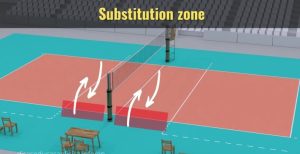Hello, friends, In this article, we are going to talk about substitution zones in volleyball and volleyball substitution rules.
Volleyball is a team sport where precise tactics and player management play crucial roles in achieving success on the court.
One of the key aspects of volleyball is the ability to make substitutions strategically.
Understanding the substitution zone in volleyball and the rules and strategies behind substitutions can greatly impact a team’s performance and chances of winning.
What is a substitution in volleyball
Substitution in volleyball is the act by which a player enters the game to occupy the position of another player.
In volleyball, the substitute player must occupy the same position as the player leaving the game in the rotation.
Rules for Substitutions in Volleyball
In volleyball, substitutions are permitted under specific circumstances:
- Injury: If a player sustains an injury during the game and is unable to continue, they can be substituted.
- Fatigue: When a player is exhausted and unable to perform at their best, a substitution can be made to maintain the team’s energy levels.
- Tactical Decision: Coaches can strategically substitute players to change the dynamics of the game or address specific challenges.
When can you make a substitution in volleyball?
Substitutions can occur before the start of the game, during breaks, or while the game is in progress. This flexibility allows teams to adapt to changing situations and optimize their performance.
See Also:
- Volleyball Nutrition – Best Foods and Eating Habits for Players
- Volleyball Players Positions and Roles Explained
- Terms in Volleyball with Definitions
- Volleyball Guide for Pregnant Women (Can you play volleyball while pregnant)
- Volleyball Tryouts 2024 – Form Evaluation & Tips for Selection
How many substitutions in volleyball are allowed?
A player in the starting lineup may leave the game once and re-enter the game once in the same set and in his or her previous position; that is, the player leaving the game may only re-enter the game in the place of the player who substituted him or her.
In this manner, a player who is on the bench at the beginning of the set may enter the game only once and maybe be substituted by the same player that he or she substituted once as well.
Substitution may vary; here is the breakdown of the number of substitutions in volleyball.
High school and collegiate volleyball
High school and collegiate volleyball provide teams with ample opportunities for substitutions, allowing up to 15 substitutions in each set. This abundance of subbing options is often utilized to replace bigger hitters and blockers in the back row with players who excel in passing and defense.
Club Volleyball
In club volleyball, teams are granted 12 substitutions per set. While still a generous number, coaches must be more discerning, particularly when employing a 6-2 offense. In this strategy, a front-row setter is replaced with an opposite player. Coaches need to be cautious, especially in tight games, as they may exhaust their allotted substitutions by the time the score reaches 17-all or 18-all.
International volleyball
On the international stage, such as the Olympics, teams are limited to just six substitutions per set.
This restriction at the highest level of the game emphasizes the need for players to possess versatile skills.
With limited opportunities for substitutions, players must be well-rounded, as specialization becomes challenging within the constraints of only six substitutions per set.
In all professional volleyball, teams are allowed up to six substitutions per game, with each substitution limited to one per player.
This rule prevents teams from repeatedly substituting the same player to gain an unfair advantage.
However, in amateur and school-level volleyball, the number of substitutions may vary depending on the tournament rules or mutual agreement between teams.
Substitution zone in volleyball

Substitutions are carried out within the substitution zone, located in the attack zone of the court occupied by the team.
The substitution request is made when the substitute player enters the substitution zone. In this way, the second referee shall use a whistle and authorize the substitution using a hand signal.
Read more: The 6 Zones in volleyball Explained
To carry out more than one substitution at once, all of the substitute players must enter the substitution zone concurrently.
See Also:
- Top 10 Best Volleyball Players of all Time
- Volleyball Nutrition – Best Foods and Eating Habits for Players
- Best Volleyball shoes, Review of different Volleyball shoes 2024
- Volleyball Passes: 7 Best Volleyball Passing Skills for Beginners
- Basic Skills in Volleyball
- What is MB in volleyball? Volleyball position terms explained
Substitution in volleyball: restrictions and considerations
While substitutions offer flexibility, there are certain restrictions to ensure fair play:
- Registered Players: Substitutions can only be made for players listed on the score sheet before the start of the match.
- Positional Integrity: Players must be replaced in their designated positions to maintain the integrity of the game.
- Return Policy: Once substituted, a player cannot return to the field until the next kickoff, except in cases of injury or the replacement of another player.
Conclusion
Effective substitutions in volleyball can be a game-changer, allowing teams to optimize their performance and adapt to evolving game conditions.
In order to carry out substitutions in volleyball, players and coaches must know the substitution zone.
By understanding the substitution zone in volleyball and the rules and strategies behind substitutions, players and coaches can make informed decisions that maximize their chances of success on the court.
Whether it’s managing fatigue, addressing injuries, or implementing tactical adjustments, smart substitutions play a vital role in the outcome of volleyball matches.



